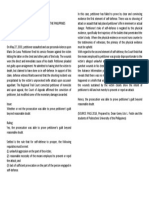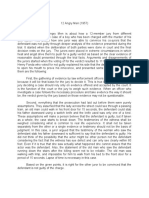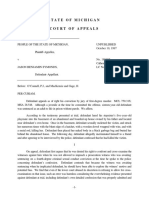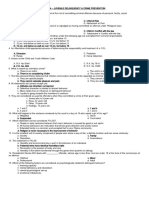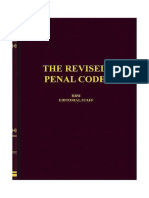0 ratings0% found this document useful (0 votes)
Case digest
Case digest
Uploaded by
Gladys HobliIn the case of People vs. Medina, Pedro Medina was found guilty of murder based on credible eyewitness testimony, leading to a sentence of life imprisonment. In People vs. Jennings, Robert Jennings was also convicted of murder after the Supreme Court ruled that his claim of self-defense was not credible, resulting in a similar sentence. Both cases underscore the importance of reliable evidence and the burden of proof in establishing self-defense claims.
Copyright:
© All Rights Reserved
Available Formats
Download as DOCX, PDF, TXT or read online from Scribd
Download as docx, pdf, or txt
Case digest
Case digest
Uploaded by
Gladys Hobli0 ratings0% found this document useful (0 votes)
In the case of People vs. Medina, Pedro Medina was found guilty of murder based on credible eyewitness testimony, leading to a sentence of life imprisonment. In People vs. Jennings, Robert Jennings was also convicted of murder after the Supreme Court ruled that his claim of self-defense was not credible, resulting in a similar sentence. Both cases underscore the importance of reliable evidence and the burden of proof in establishing self-defense claims.
Copyright
© © All Rights Reserved
Available Formats
DOCX, PDF, TXT or read online from Scribd
Share this document
Did you find this document useful?
Is this content inappropriate?
In the case of People vs. Medina, Pedro Medina was found guilty of murder based on credible eyewitness testimony, leading to a sentence of life imprisonment. In People vs. Jennings, Robert Jennings was also convicted of murder after the Supreme Court ruled that his claim of self-defense was not credible, resulting in a similar sentence. Both cases underscore the importance of reliable evidence and the burden of proof in establishing self-defense claims.
Copyright:
© All Rights Reserved
Available Formats
Download as DOCX, PDF, TXT or read online from Scribd
Download as docx, pdf, or txt
0 ratings0% found this document useful (0 votes)
Case digest
Case digest
Uploaded by
Gladys HobliIn the case of People vs. Medina, Pedro Medina was found guilty of murder based on credible eyewitness testimony, leading to a sentence of life imprisonment. In People vs. Jennings, Robert Jennings was also convicted of murder after the Supreme Court ruled that his claim of self-defense was not credible, resulting in a similar sentence. Both cases underscore the importance of reliable evidence and the burden of proof in establishing self-defense claims.
Copyright:
© All Rights Reserved
Available Formats
Download as DOCX, PDF, TXT or read online from Scribd
Download as docx, pdf, or txt
You are on page 1/ 2
Case digest
1.people vs. medina
Case Title: People of the Philippines vs. Pedro Medina
Facts:
Pedro Medina was accused of killing one Isidro A. Garcia. The victim was reportedly
shot by Medina, and the prosecution presented eyewitness testimony linking Medina to
the crime. However, Medina raised the defense that he was not the one who committed
the act. Additionally, the defense argued that the prosecution’s evidence was insufficient
and that the identification of the shooter was flawed.
Issues:
The primary issue in the case was the identification of the perpetrator and whether
the evidence presented by the prosecution was enough to establish guilt beyond a
reasonable doubt. Another issue raised was the admissibility of certain evidence that
the defense argued should be excluded.
Ruling:
The Supreme Court ruled in favor of the prosecution, finding that the eyewitness
testimony was credible and consistent. The Court emphasized that identification of the
accused was clear and convincing and that the circumstances surrounding the crime
were consistent with the prosecution's theory.
Furthermore, the Court upheld the conviction based on the evidence, as it determined
that the defense's argument regarding the insufficiency of evidence was without merit.
The ruling was significant because it reaffirmed the importance of reliable eyewitness
testimony in establishing the identity of a perpetrator in criminal cases.
Decision:
The accused, Pedro Medina, was found guilty of murder and sentenced to reclusion
perpetua (life imprisonment). The case highlighted the importance of evaluating
eyewitness accounts and the need for the prosecution to present a solid case to secure
a conviction.
2. people vs. jenning
Case Title: People of the Philippines vs. Robert Jennings
Citation: G.R. No. 126040, February 25, 1999
Facts:
Robert Jennings, an American national, was charged with murder for the killing of a
certain victim, Amado Ruiz, in a heated argument. Jennings, in his defense, claimed
that he acted in self-defense, stating that the victim had attacked him with a knife and
that he had no intention to kill the victim but acted out of fear for his life.
The prosecution, on the other hand, argued that Jennings had a clear intention to kill the
victim and that he was not in imminent danger when he attacked. The prosecution
presented evidence that Jennings’ actions were not consistent with the claim of self-
defense and that the nature of the injuries sustained by the victim suggested that it was
not a case of self-defense.
Issues:
1. Whether or not the accused was justified in killing the victim under the claim of
self-defense.
2. Whether the circumstantial evidence presented by the prosecution was enough
to overcome the claim of self-defense.
Ruling:
The Supreme Court found that the accused, Robert Jennings, was guilty of murder.
The Court ruled that the claim of self-defense was not credible because Jennings failed
to prove that he was in imminent danger of losing his life or suffering great bodily harm
at the time of the killing.
The Court also noted that the nature of the wounds and the lack of sufficient evidence to
substantiate Jennings' claim of self-defense indicated that his actions were not merely in
response to an immediate threat but were deliberate and intended to kill.
Decision:
Robert Jennings was convicted of murder and sentenced to reclusion perpetua (life
imprisonment). The Court ruled that the prosecution had successfully disproven the
claim of self-defense by showing that the killing was not done out of necessity but out of
a deliberate intent to kill.
Principles:
A claim of self-defense must be supported by clear and convincing evidence
that the accused was in imminent danger.
Self-defense can only be invoked if the act was necessary to prevent an
unlawful aggression, and the force used must be proportionate to the threat.
The burden of proof shifts to the accused to prove that they acted in self-
defense, once the prosecution establishes that the killing was not justified.
You might also like
- R. v. Hudson: Between Her Majesty The Queen, Respondent, and Damian Hudson, ApplicantNo ratings yetR. v. Hudson: Between Her Majesty The Queen, Respondent, and Damian Hudson, Applicant10 pages
- Affidavit in Support of Redacted - Asylum - Office - BriefNo ratings yetAffidavit in Support of Redacted - Asylum - Office - Brief17 pages
- PO1 CRISPIN OCAMPO y SANTOS v. PEOPLE OF THE PHILIPPINES100% (1)PO1 CRISPIN OCAMPO y SANTOS v. PEOPLE OF THE PHILIPPINES1 page
- Plaintiff-Appellee Vs Vs Accused-Appellant The Solicitor General Public Attorney's OfficeNo ratings yetPlaintiff-Appellee Vs Vs Accused-Appellant The Solicitor General Public Attorney's Office9 pages
- Digest: People vs. De los Reyes (G.R. No. 140680)No ratings yetDigest: People vs. De los Reyes (G.R. No. 140680)6 pages
- (G.R. No. 168827. April 13, 2007.) Benjamin P. Martinez, Petitioner, Vs - Court of Appeals and People of The PHILIPPINES, Respondents100% (1)(G.R. No. 168827. April 13, 2007.) Benjamin P. Martinez, Petitioner, Vs - Court of Appeals and People of The PHILIPPINES, Respondents5 pages
- ARTICLE 14. AGGRAVATING CIRCUMSTANCES - 01 - People v. Rodil, 109 SCRA 308No ratings yetARTICLE 14. AGGRAVATING CIRCUMSTANCES - 01 - People v. Rodil, 109 SCRA 30822 pages
- Plaintiff-Appellee Vs Vs Accused-Appellant The Solicitor General Public Attorney's OfficeNo ratings yetPlaintiff-Appellee Vs Vs Accused-Appellant The Solicitor General Public Attorney's Office21 pages
- S v Pienaar (CC 26-2019) [2021] NAHCMD 369 (13 August 2021) (1)No ratings yetS v Pienaar (CC 26-2019) [2021] NAHCMD 369 (13 August 2021) (1)29 pages
- People of The Philippines v. Democrito Paras0% (1)People of The Philippines v. Democrito Paras2 pages
- Brief Fact Summary. Ernestine James's (Defendant-Appellant's)No ratings yetBrief Fact Summary. Ernestine James's (Defendant-Appellant's)44 pages
- G.R. No. 195534 June 13, 2012 People of The Philippines, Appellee, EDUARDO GONZALES, AppellantNo ratings yetG.R. No. 195534 June 13, 2012 People of The Philippines, Appellee, EDUARDO GONZALES, Appellant6 pages
- United States Court of Appeals, Third CircuitNo ratings yetUnited States Court of Appeals, Third Circuit20 pages
- People v. Nicholas y Mabena, G.R. No. 142044, November 23, 2001No ratings yetPeople v. Nicholas y Mabena, G.R. No. 142044, November 23, 20014 pages
- Henderson v. Morgan, 426 U.S. 637 (1976)No ratings yetHenderson v. Morgan, 426 U.S. 637 (1976)17 pages
- United States v. Martel Lawes, 292 F.3d 123, 2d Cir. (2002)No ratings yetUnited States v. Martel Lawes, 292 F.3d 123, 2d Cir. (2002)13 pages
- 4.people vs. Rodil, G.R. No. L-35156, Nov. 20, 1981No ratings yet4.people vs. Rodil, G.R. No. L-35156, Nov. 20, 198122 pages
- Sean Robinson Murder Case Upheld by Ga Supreme CourtNo ratings yetSean Robinson Murder Case Upheld by Ga Supreme Court6 pages
- Putative Self-Defence: Private Versus Putative Private Defence - What Is The Difference?No ratings yetPutative Self-Defence: Private Versus Putative Private Defence - What Is The Difference?33 pages
- Rebooting Justice: More Technology, Fewer Lawyers, and the Future of LawFrom EverandRebooting Justice: More Technology, Fewer Lawyers, and the Future of LawNo ratings yet
- Preliminary Project of Criminal Procedure Code: Submitted By: Submitted ToNo ratings yetPreliminary Project of Criminal Procedure Code: Submitted By: Submitted To5 pages
- Crime Branch CID (Crime Investigation Department) (Sometimes Known AsNo ratings yetCrime Branch CID (Crime Investigation Department) (Sometimes Known As3 pages
- The Red RecordTabulated Statistics and Alleged Causes of Lynching in The United States by Wells-Barnett, Ida B., 1862-1931No ratings yetThe Red RecordTabulated Statistics and Alleged Causes of Lynching in The United States by Wells-Barnett, Ida B., 1862-193163 pages
- Acknowledgement: (Affiliated To Jnvu, Jodhpur) Ba - LLB 6 SemesterNo ratings yetAcknowledgement: (Affiliated To Jnvu, Jodhpur) Ba - LLB 6 Semester12 pages
- United States v. Ewell, 383 U.S. 116 (1966)No ratings yetUnited States v. Ewell, 383 U.S. 116 (1966)10 pages
- Offence of Zina (Enforcement of Hudood) Ordinance, 1979No ratings yetOffence of Zina (Enforcement of Hudood) Ordinance, 19796 pages
- Sri Lankan Perspective in Meeting The Cyber Crime ChallengeNo ratings yetSri Lankan Perspective in Meeting The Cyber Crime Challenge24 pages
- CSEA State On NYS Juvenile Detention CentersNo ratings yetCSEA State On NYS Juvenile Detention Centers3 pages
- Jonathan "Ynot" Corso: The Police ReportNo ratings yetJonathan "Ynot" Corso: The Police Report5 pages














